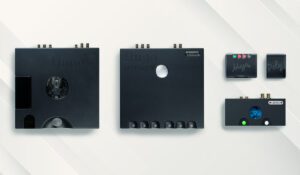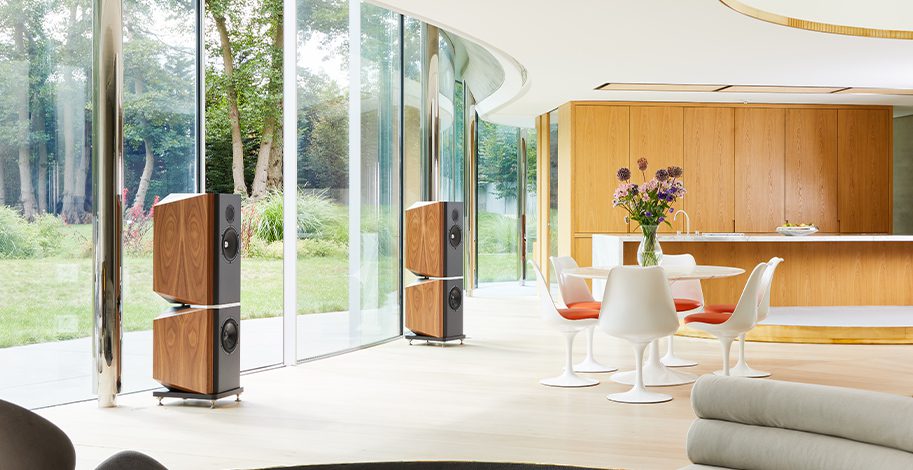
I reviewed the Kudos Titan 707 floorstanders back in issue 192. They left a lasting impression for the sheer depth of tonal colour they drew out of my recordings, and their ability to convincingly portray the scale of a performance. What also impressed me was the ease with which they insinuated themselves into my very modest listening space. So <looks sidelong at a pair of Titan 808s> we all wondered what might happen if we brought along their bigger siblings, Kudos’ flagship, four-box Titan 808 and put them in the same space. Kudos are adamant that their clever reflex port boundary loading arrangement doesn’t need much space behind the cabinet to breathe, so we’d be okay with placing them quite close to the wall, as we had done with the Titan 707s.
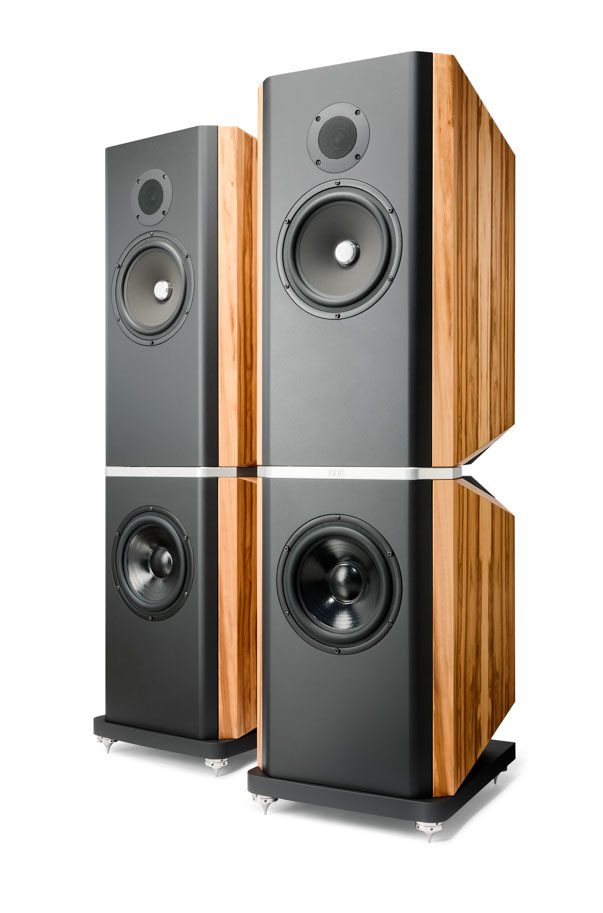
So, they duly arrived, and they were right. For a reasonably substantial loudspeaker, the £28,500 Titan 808 (£30,000 in piano gloss) has been sitting happily barely a foot away from my bay window and making great music. It helps, of course, that it’s a relatively benign room, with decent equipment stands that deal well with acoustic feedback at source. So, aside from some small (and easily ignored) mid-bass room gain, there are no issues to speak of that might be energised by a full-range loudspeaker.
Different from the rest
The Titan 808 is a four-box, two-and-a-half-way design, differing from all the other models. A substantial upper cabinet houses the bespoke Crescendo tweeter and a 220mm mid-bass unit, while the lower, bass-only, cabinet features a pair of 220mm units configured isobarically – back-to-back with a sealed chamber between them; one front-facing driver and an identical unit mounted internally, connected out of phase so as one ‘pushes’ the other ‘pulls’ and the volume of air between them remains constant. The rearward-facing driver also feeds into another chamber which vents via a reflex port. The two cabinets sit one above the other, each venting a port into the space between the cabinets in a controlled boundary loading configuration, guided by a solid, shaped aluminium plate.
This loading, common to all Titan designs from the stand-mount 505 up, minimises interaction between the port vents and any nearby walls or surfaces and is mainly responsible for the Titans’ accommodating nature when placed near walls. The cabinets also feature Kudos’ panel resonance control, with thin internal walls married to a thicker front baffle, and even thicker, but non-structural outer walls and trim attached using resonance control materials. This is a marriage of the classic BBC ‘light and stiff’ approach, for agility and minimal cabinet coloration, together with more modern materials and design techniques to better manage what is a reasonably high mass cabinet. Thanks to this design it behaves more like the BBC ideal and doesn’t store energy as much as its substantial weight might lead you to expect.

So, they’re in and behaving themselves, and one difference between these and the Titan 707s is immediately apparent. The ‘mid hall’ acoustic presentation I noted in the 707s is not there; if your favourite seats are front row centre, the Titan 808s can oblige. But what is still very much present is that rich tonal palette which impressed me in the 707s. The 808s make every instrument sound like a better version of itself. Plucked double bass has depth, but also body and a woody sonority that some loudspeakers can only hint at; an acoustic piano is another: solid, fully fleshed-out bass notes give a real sense of the size and scale of the instrument. ‘Llego Cachaito’ from Roberto Fonseca’s album Zamazu (Enja) is one such combination, and I’ve rarely heard it more realistically portrayed. The piano has absolute power, the bass playing natural body and depth, and both exhibit a tunefulness that speaks to an accurate rendition of the complete note envelope, from fundamental to the higher harmonics. Percussion, too, the drum skins had their own textures, and cymbals a lovely, multi-layered metallic shimmer. This makes acoustic and orchestral recordings a real treat, and vocals a joy and is, I think, where the Titan 808 excels; the class of the Titan’s bespoke Kudos/SEAS drivers is very evident, and the work in minimising cabinet coloration has paid dividends.
Toe No-No
Kudos usually doesn’t recommend toeing-in of its loudspeakers because the tweeter design is intended to be listened to off‑axis, so we installed them facing straight down the room, rather than my customary toed-in positioning. But this created a bit of a hole in the middle, a mild vagueness to the stereo image, particularly evident in things like jazz trios and quartets where it’s usually easy to place individual performers accurately.
Chatting with the Kudos team, they suggested moving the two loudspeakers closer together due to the nearfield listening position, which helped a lot. This meant the cabinets could be toed-in very slightly, just a couple of degrees while maintaining focus, and better driver integration. While a bigger space than mine would allow much more latitude without needing to listen on-axis, getting a loudspeaker like the Kudos Titan 808 to work in a small room like mine is a sign of sophisticated engineering and design skills at work. Often larger speakers in a small room can sound like the World’s Biggest Headphones, but not with the Kudos Titan 808.
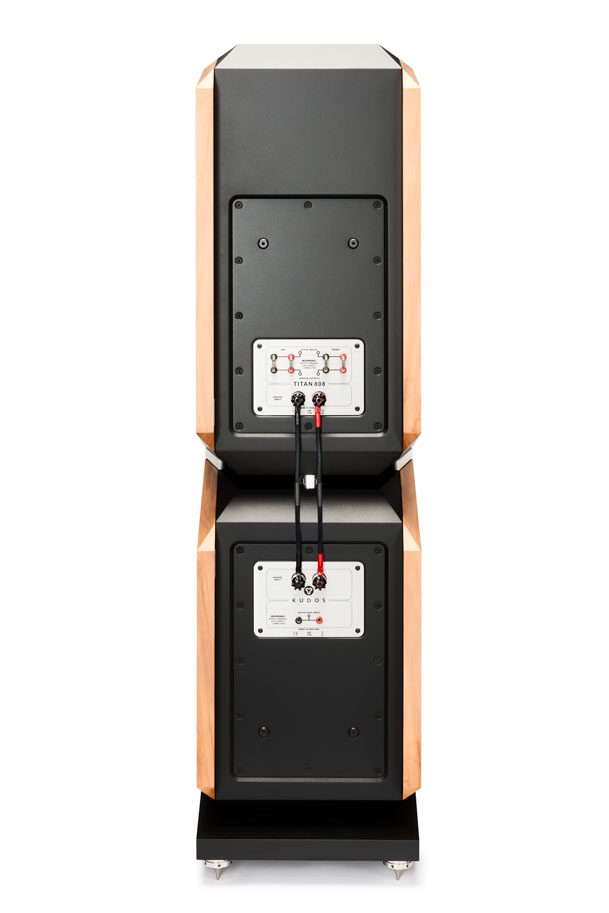
As you might expect, large-scale classical is a particular forte for the Titan 808s. Freddy Kempf, Prokofiev, Piano Concerto No. 2 (BIS, SACD) has all the scale and weight I could have wished for. The power and sonority of the piano is beautifully balanced by the scale of the orchestra and lots of nuanced detail in the phrasing. Also the interplay between soloist and ensemble, including all the subtle little orchestral lines that provide a counterpoint to the main phrases. Here was a truly accomplished performance; it was effortlessly easy to hear exactly what was going on, how the composer had structured everything to produce a cohesive whole. The RPO playing Sibelius, Karelia Suite (Tring) had a gloriously rich and suitably raucous brass tone with just enough ‘edge’ but never straying into sourness; propulsive, pacey, and persuasive, the contrast between brass and strings creating layers of tonal colour you feel you can wade through.
Active or Passive
The Titan range can be configured for active or passive operation. I heard them in active mode at a recent factory tour, but this review used them purely in passive mode. Suffice it to say, active is worth exploring, greater focus and better management of the energy in the performance are clear benefits but the Titan 808s are no slouch in passive mode either. The two-box design lends itself naturally to bi-wiring; each box has its own input panel, which can be connected by bi-wiring, but Kudos also provides links for single-wired operation. Made from short lengths of Kudos’ loudspeaker cable, these are a cut above the usual links.
Kudos left the loudspeakers connected with the input to the main box, linking to the bass units, but suggested I might be interested in a small experiment with the other option. I tried the alternative of inputting the signal to the bass and linking to the main unit, but I felt this muddied the timing somewhat. This also highlighted something else; I listened to much more classical, primarily orchestral and choral, and much less jazz through these speakers in this setting.
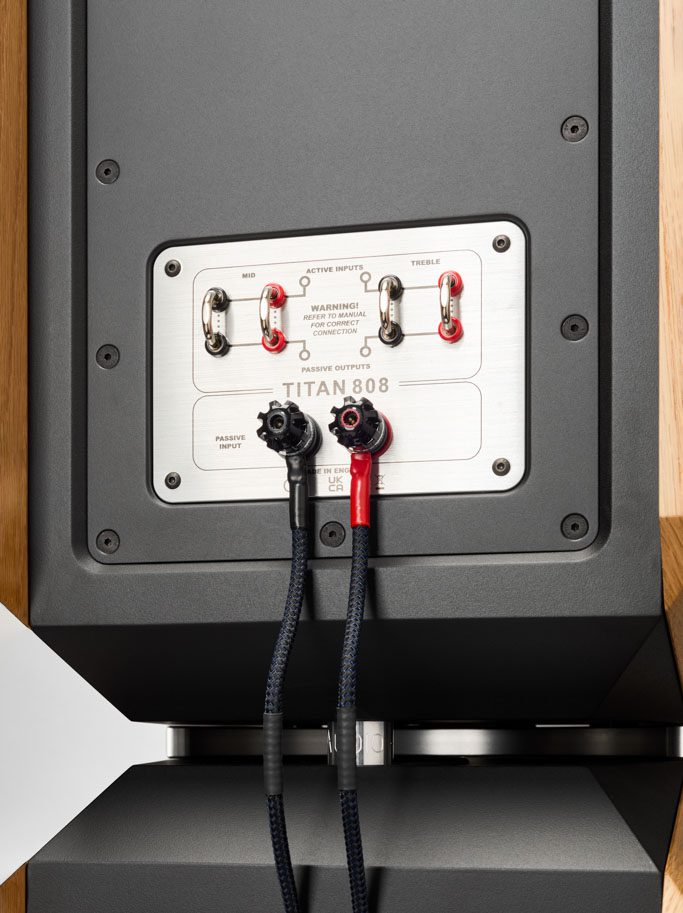
To a large extent, this was because the 808s are just breathtakingly good with large-scale performances, so I was hearing a new dimension to my classical collection, and the vocal and instrumental timbres have rarely sounded so rich and authentic. But on jazz, the music wasn’t drawing me in quite how it should; Yuon Sun Nah is a Korean singer with an almost supernatural vocal range and agility. Her album ‘Some Girl’ (ACT) has her perform a vocal version of Asturias; here it was stunning in its vocal acrobatics, but less so in terms of her musical sensitivity. You could easily assume the point of this track was to show off. However, I know differently, because I’ve heard how expressive and subtle she can be. Happily, there is a third way to connect these loudspeakers which more closely mimics bi-wiring mode…
Splitters!
As I have a finite amount of Nordost speaker cable, I fashioned a pair of single-wire to bi-wire splitters made up of two equal, short lengths of loudspeaker cable, twinned together into two sockets at the upstream end and split into the four plugs at the other end. This was noticeably better: timing tightened up, pieces evoked more tension, jazz made more sense and even those works which had impressed me before, drew me more deeply into the performance. Now the opening strings of the Karelia Suite created a real sense of anticipation, the early call of the distant brass full of promise that wasn’t quite fulfilled hitherto.
The opening movement of Shostakovich Symphony No. 7 (Sony, Essential Classics) built up to its compelling, relentless climax; here now was a real sense of portent, menace, and impending denouement. But it also showed that the interplay between the parts isn’t just thematic, the composer is also playing with the spatial arrangement, blocks of sound playing off against each other. These are the sort of insights you get from a live performance, and this is what you can get from active mode, but it turns out you can have much of it passively too, for a little bit of effort.
Bi-wiring links can be an Achilles’ heel if you run single-wired, and despite the quality of the links supplied, this turned out to be just such a case. I suspect that the near-field nature of my experience exacerbated these effects, or maybe it just highlighted them. And that’s the thing. These are not inexpensive loudspeakers, this is proper high-end stuff, and I’m learning that at this level, setup matters. But also, of course, using equipment in an environment it was designed for if you want the best from it. Perhaps the most important thing I learned was that yes, we could get these loudspeakers to work in a small space without overpowering it, and yes, we could get some seriously good results for the price of a little bit of experimentation with setup. Still, in all seriousness, these are not the right loudspeakers for this job.
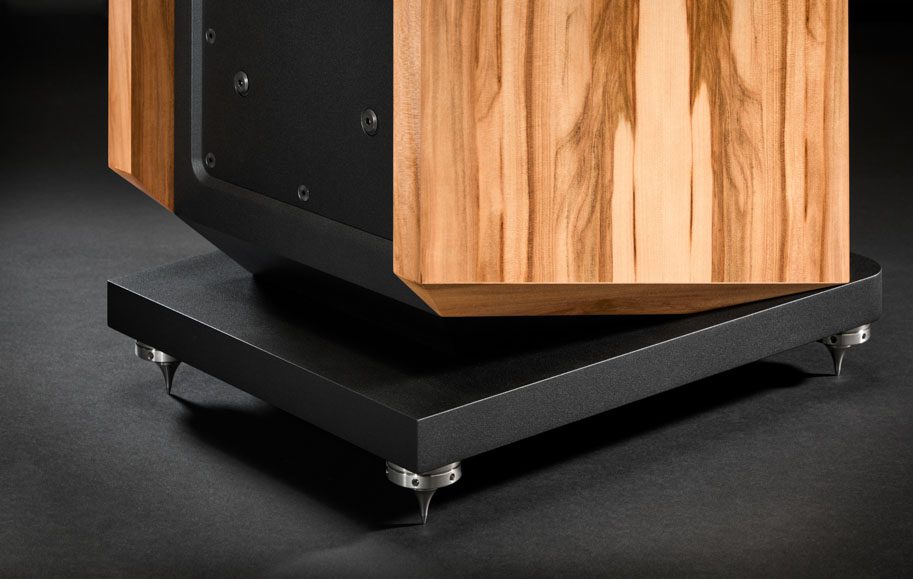
I didn’t want to focus too heavily on the connections to a loudspeaker and instead wanted to highlight the performance of the loudspeaker in its own right. However, this also ably describes the potential of this loudspeaker. The Kudos Titan 808 can reveal the smallest of personalisation to dial in your ideal loudspeaker. That’s a transducer of rare resolution.
Ferrari in the City
The Kudos 808s are designed to work irrespective of room size – but for a room like mine, I think pretty much any of the Titan range (including the 808s) would perform superbly – I know for sure the 707s do. However, what was remarkable was how well the Titan 808s performed, given the space limitations to which they were subjected. It’s a testament to Kudos’ design that they weren’t overpowering, overblown or overwrought, but that they nevertheless brought a sense of scale to the music which was entirely appropriate in my modest listening space. Most importantly, they communicated the music and its emotional connection in the music.
Aside from their physical size, the Kudos Titan 808s were no challenge to get working well in my ‘Lilliputian’ listening room, something I doubt holds true for most speakers capable of a 20Hz in-room response. However, such is the flexibility of the Kudos Titan 808 that most room-related ‘insurmountable obstacles’ that challenge full-range speakers can be resolved. The Titan 808 is clearly a genuinely impressive loudspeaker and is more than capable of delivering a musical experience entirely commensurate with their price. And remember, these results are from passive mode; actively driven Titan 808s raise the stakes a lot higher!
Technical specifications
- Type Split cabinet floor standing, 2.5-way isobaric loudspeaker with bass reflex loading and staggered tune fixed boundary port alignment
- Driver complement 2 × Kudos-seas 220mm double coated paper cone bass units; 1 × Kudos-seas 220mm tri-lam Nextel coated Bass Mid unit, 39mm voice coil with copper shorting ring and aluminium phase plug; 1 × Kudos-seas Crescendo K3 29mm fabric dome tweeter
- Power handling 25–300W (recommended)
Crossover frequencies wide band acoustic 200hz and 2.6khz - Crossover type Single wire passive/Bi-amp passive/Tri amp active, 1st order low pass bass, 1st order low pass bass mid, 2nd order high pass, hard wired using Mundorf Transformcore and MCoil Foil inductors, Mundorf Mresist Supreme resistors and Kudos Copper Connect capacitors
- Frequency response (average in-room response) 20Hz–30kHz
- Impedance 8 Ohms nominal
- Sensitivity 91dB for 1 Watt at 1 Metre
- Dimensions (H×W×D) 1,168 × 348 × 404mm
- Weight 75 Kg (per loudspeaker)
- Finishes Piano Gloss Black/Piano Gloss White (premium options); Black Oak, Natural Oak, Liquid Amber; Walnut.
- Price £28,500/pair £30,000/pair Piano Gloss
Manufacturer: Kudos Audio
Tel: +44(0)1388 417177
By Steve Dickinson
More articles from this authorRead Next From Review
See all
PrimaLuna EVO 100 phono preamplifier
- Apr 22, 2024

Reiki Audio SuperSwitch Master Pro + Servant Pro
- Mar 27, 2024

Melco Audio N1-S38 music server
- Mar 27, 2024









